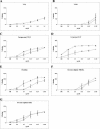Inhibition of chondroitin-4-sulfate-specific adhesion of Plasmodium falciparum-infected erythrocytes by sulfated polysaccharides
- PMID: 15972521
- PMCID: PMC1168624
- DOI: 10.1128/IAI.73.7.4288-4294.2005
Inhibition of chondroitin-4-sulfate-specific adhesion of Plasmodium falciparum-infected erythrocytes by sulfated polysaccharides
Abstract
Adhesion of Plasmodium falciparum-infected erythrocytes to placental chondroitin 4-sulfate (CSA) has been linked to the severe disease outcome of pregnancy-associated malaria. Soluble polysaccharides that release mature-stage parasitized erythrocytes into the peripheral circulation may help elucidate these interactions and have the potential to aid in developing therapeutic strategies. We have screened a panel of 11 sulfated polysaccharides for their capacities to inhibit adhesion of infected erythrocytes to CSA expressed on CHO-K1 cells and ex vivo human placental tissue. Two carrageenans and a cellulose sulfate (CS10) were able to inhibit adhesion to CSA and to cause already bound infected erythrocytes to de-adhere in a dose-dependent manner. CS10, like CSA and in contrast to all other compounds tested, remained bound to infected erythrocytes after washing and continued to inhibit binding. Both carrageenans and CS10 inhibited adhesion to placental tissue. Although highly sulfated dextran sulfate can inhibit CSA-mediated adhesion to CHO cells, this polysaccharide amplified adhesion to placental tissue severalfold, demonstrating the importance of evaluating inhibitory compounds in systems as close to in vivo as possible. Interestingly, and in contrast to all other compounds tested, which had a random distribution of sulfate groups, CS10 exhibited a clustered sulfate pattern along the polymer chain, similar to that of the undersulfated placental CSA preferred by placental-tissue-binding infected erythrocytes. Therefore, the specific anti-adhesive capacity observed here seems to depend not only on the degree of charge and sulfation but also on a particular pattern of sulfation.
Figures



References
-
- Achur, R. N., M. Valiyaveettil, A. Alkhalil, C. F. Ockenhouse, and D. C. Gowda. 2000. Characterization of proteoglycans of human placenta and identification of unique chondroitin sulfate proteoglycans of the intervillous spaces that mediate the adherence of Plasmodium falciparum-infected erythrocytes to the placenta. J. Biol. Chem. 275:40344-40356. - PubMed
-
- Achur, R. N., M. Valiyaveettil, and D. C. Gowda. 2003. The low sulfated chondroitin sulfate proteoglycans of human placenta have sulfate group-clustered domains that can efficiently bind Plasmodium falciparum-infected erythrocytes. J. Biol. Chem. 278:11705-11713. - PubMed
-
- Aikawa, M., M. Iseki, J. W. Barnwell, D. Taylor, M. M. Oo, and R. J. Howard. 1990. The pathology of human cerebral malaria. Am. J. Trop. Med. Hyg. 43:30-37. - PubMed
-
- Alkhalil, A., R. N. Achur, M. Valiyaveettil, C. F. Ockenhouse, and D. C. Gowda. 2000. Structural requirements for the adherence of Plasmodium falciparum-infected erythrocytes to chondroitin sulfate proteoglycans of human placenta. J. Biol. Chem. 275:40357-40364. - PubMed
-
- Andrews, K. T., N. K. Viebig, F. Wissing, N. Klatt, N. Oster, H. Wickert, P. Knolle, and M. Lanzer. 2003. A human schwannoma cell line supports the in vitro adhesion of Plasmodium falciparum infected erythrocytes to chondroitin-4-sulfate. Parasitol. Res. 89:188-193. - PubMed
Publication types
MeSH terms
Substances
LinkOut - more resources
Full Text Sources

